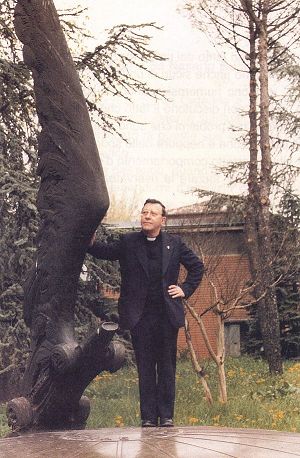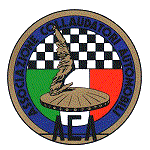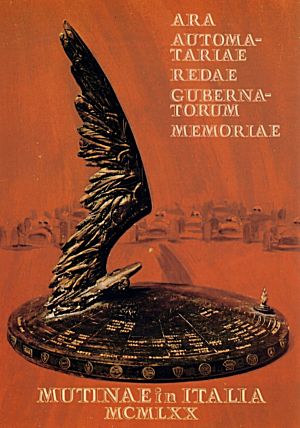|
Now he is dead, he lies on the edge of the track, the car once worth 20 million Lire is a mass of wrecked steel, on the ground there is a large patch of oil, black smoke fills the air, the other drivers continue to race, unless stopped by a red flag, until the chequered flag. And what of him?
For a few days in the newspapers, on the radio, on the TV, they beat the drums. Is it worth taking such risks? Can they, must they pass certain limits? Yes or No? After a day or two the headlines become smaller, three columns then two, and after a week or so nothing.
What remains of a racing driver after he is dead and the newspapers, radio, TV and even the people don't talk about him anymore? You do not need to be told that disc brakes and another one hundred other devices which are now in everyday use in your car originated from these very experiences. It is too easy and this you already know. But what still remains?
On the morning of the 9th October, 1960 at the Modena Autodrome, the Junior Grand prix was taking place, a race of little importance. At the North bend, a De Sanctis car No 18 crashed into a bale of straw, sending it into the air, turning it over. Everyone came running from the pits, an ambulance with its siren blaring passed by and that was all. The next day the newspapers announced that driver Giuseppe Faranda from Patti, Messina had been killed. Most people didn't know him. The person who searched his racing suit for an identity card found a small piece of paper neatly folded into four. It was his will. "In the event that I should be killed in an accident, I Giuseppe Faranda, wish that my body be used for scientific and humanitarian use. Therefore in order that my last wish be carried out, I shall be very grateful to those doctors who may use my eyes for transplant purposes and who use any other parts of my body for studying, for scientific experimentation and any other use that may be to the benefit of mankind."
Today two people who were once blind can now see. With the eyes of Faranda they can see the houses they live in, the flowers, the sky, the stars and the faces of their fellow countrymen and women. This is what remains of a dead racing driver.
Racing drivers are neither the aristocratic playboys nor the madmen looking for adventure, that most people think they are. If you are not dedicated, intelligent with above normal reflexes, generous, unselfish and honest then you cannot drive at speeds in excess of 200 kph, when the road becomes just a long white line and the surrounding trees, houses and the faces of spectators appear as green, yellow and pink patches that rush past.
A sense of death always lives within the racing driver. Ask Don Sergio Mantovani, a Parish priest of Modena and Father to the drivers. Don Sergio was Father to the Maserati factory and one day he came up with an idea. He observed that in the pits during races one sees mechanics, nurses, firemen and many others, but one never sees a priest. Don Sergio decided to join everyone in the pits and soon became friendly with everyone, especially French racing driver Jean Behra with whom he often spoke. They also discussed the subject we have just covered, namely what remains of a driver and all of us when we are dead ?
One day Jean Behra said "We must think of the little ones in the Parish and build a good nursery school, full of light. At the beginning of life there must be joy for everyone for there will be enough dark days in the years to come." A week later at the Avus Autodrome in the suburbs of Berlin, Behra's Porsche left the track and he was killed. The newspapers played the same old music we have heard before. All this excessive risk and for what benefit ?
Where is the benefit? Behra had left a small sum of money to Don Sergio, other drivers and some of the constructors gave him more. And so was born the nursery school that Behra and Don Sergio had discussed. The first classroom was named after Behra, the second after Faranda, the third after Castellotti and the fourth after Von Tripps. It was the best infant school in Modena with modern classrooms, a chapel, a terrace, a large garden and many toys for the children. When it was inagurated on the 3rd of December, 1961, it was attended by the most famous names in the racing world. In attendance were the mother and father of Faranda, the mother of Castellotti, the wife of Behra and the brother of Crivellari. With the little children in their freshly ironed aprons and ribbons looking on, the Archbishop of Modena had touching words to say: "These children will be the guardian angels who will pray for and stand guard over these dead drivers and for those who are still racing." Then Fangio cut the ribbon.
In the school entrance hall on a wall, written in bronze, are the names of dead drivers. A long list. Reading it makes your heart cry. Bonetto, Marimon, Ascari, Castellotti, De Portago, Sighinolfi, Musso, Collins, Hawthorn, Schell, Faranda, Cablanca, Crivellari, Von Tripps, Rodriguez. Now the walls are full of names. One does not know where to put the names of Bandini, Clark, Scarfiotti, Courage, McClaren, Rindt and Giunti. Now Don Sergio has another idea. All drivers from Faranda to Rindt, from champions to those less known, to the unknown, Italian, French, English, Scottish, German, American, all of them must be remembered.
Aided and encouraged by friends, Don Sergio has commissioned the sculptor Marino Quartieri to prepare a beautiful bronze memorial, which is to be placed in the centre of Modena.
A large wing mounted on a racing car reaches upwards cutting the sky in two: it is placed on a hemisphere whch symbolises the world, and engraved on it are the names of the drivers killed whilst racing and all around the circuference and the badges and motifs of all the companies associated in making and supporting racing cars.
This is the reason why when a driver is killed, something must remain of him, and with this infant school, with this memorial and above all in our hearts, their memory will never die. |
Translated from an article by Gian Carlo Silingardi.
| |
| |
| |
| |
 |
| |
| |
|
Please help if you can! |
| |
If you are ever fortunate enough to visit Modena, you will no doubt head straight for the Maserati factory. You might then want to see the Panini Collection at the Hombre Farm just outside Modena.
It would be a great pity if you left Modena without visiting the Parco Della Scuola Materna, not far from the Maserati factory. There you will find a magnificent bronze memorial, sculptured by Marino Quartieri, dedicated to the many drivers, from all over the world, who have sadly lost their lives whilst racing.
Alongside the memorial stands a column 30 metres (100 feet) tall on top of which is an illuminated flame that at one time could even be seen by motorists travelling south, from Milano, on the Autostrada del Sole. Since the first year of illumination, the flame has been extinguished, due to lack of funds, and has remained so for the past 30 years.
Now, after 30 years of neglect, Don Sergio Mantovani, with the help of a loan of IT L50,000,000 (around US $25,000 - GB £15,000), has had the memorial restored.
This substantial amount must now be found and thanks largely to the fund raising efforts of Don Sergio and the A.C.A. they are on their way, but there is still a long way to go! Most of the money collected so far has been by way of small donations from motor sport enthusiasts from all over Italy. The flame must be illuminated once more!
Your help is needed! More funds are required to finish paying for this project and Don Sergio Mantovani, the F1 driver's pastor, is asking motor sport enthusiasts worldwide to show their support, by way of cash donations, so that the flame in memory of the many racing drivers, worldwide, who lost their lives during competition and during practice may be illuminated permanently. |
| |
 |
Don Sergio Mantovani stands alongside the "Ara" in memory of the racing drivers who have lost their lives.
The work in bronze, by the sculptor Marino Quartieri, was erected in the Parco della Scuola Materna in 1970. |
| |
If you feel you can help by making a contribution, no matter how small, to this worthwhile project. Please send your contributions in US$, GB£ or Euros to:
Don Sergio Mantovani
Casa della Gioia e Sole
Via Mar Mediterraneo, 84
41100 Modena
Italia.
Tel: 0039-059-251407
OR
Sig. Romano Biolchini
A.C.A. Associazione Collaudatori Automobili
Via Ulpiano Domizio, 1
20146 Milano
Italia.
e-mail: info@associazionecollaudatori.it
You can read more about the origins of the memorial by clicking HERE!
|
| |

|
|
To enter Enrico's Maserati Pages CLICK HERE!
Copyright: Enrico's Maserati Pages - © 2002-2004. All rights reserved. |
|



